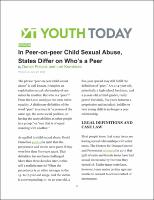Please use this identifier to cite or link to this item:
https://hdl.handle.net/20.500.12202/5862Full metadata record
| DC Field | Value | Language |
|---|---|---|
| dc.contributor.author | Pollack, Daniel | |
| dc.contributor.author | Kornblum, Lori S. | |
| dc.date.accessioned | 2020-07-29T18:21:51Z | |
| dc.date.available | 2020-07-29T18:21:51Z | |
| dc.date.issued | 2020-07-29 | |
| dc.identifier.citation | Pollack, Daniel and Kornblum, Lori S. (July 29, 2020). In peer-on-peer child sexual abuse, states differ on who’s a peer. Youth Today. | en_US |
| dc.identifier.issn | 1089-6724 | |
| dc.identifier.uri | In peer-on-peer child sexual abuse, states differ on who’s a peer. | en_US |
| dc.identifier.uri | https://hdl.handle.net/20.500.12202/5862 | |
| dc.description | Opinion | en_US |
| dc.description.abstract | The phrase “peer on peer child sexual abuse” is well known. It implies an exploitative sexual relationship of one minor by another. But who is a “peer”? From the Latin word par the term infers equality. A dictionary definition of the word “peer” as a noun is “a person of the same age, the same social position, or having the same abilities as other people in a group,” or “one that is of equal standing with another.” As applied to child sexual abuse, David Finkelhor posited in 1986 that the perpetrator and victim were peers if they were less than five years apart. That definition has not been challenged. More than three decades later, is this still a realistic metric? When the perpetrator is an older teenager in the 15- to 17-year-old range, and the victim is a corresponding 10- to 12-year-old, a five-year spread may still fulfill the definition of “peer.” Are a 14-year-old, potentially a high school freshman, and a 9-year-old, a third-grader, really peers? Certainly, five years between a perpetrator and an infant, toddler or very young child is no longer a peer relationship. | en_US |
| dc.language.iso | en_US | en_US |
| dc.publisher | GA: Kennesaw State University | en_US |
| dc.relation.ispartofseries | Youth Today; | |
| dc.relation.ispartofseries | ;July 29, 2020 | |
| dc.rights | Attribution-NonCommercial-NoDerivs 3.0 United States | * |
| dc.rights.uri | http://creativecommons.org/licenses/by-nc-nd/3.0/us/ | * |
| dc.subject | age of consent | en_US |
| dc.subject | peer-on-peer | en_US |
| dc.subject | sexual abuse | en_US |
| dc.title | In peer-on-peer child sexual abuse, states differ on who’s a peer. | en_US |
| dc.type | Article | en_US |
| dc.contributor.orcid | 0000-0001-7323-6928 | |
| local.yu.facultypage | https://www.yu.edu/faculty/pages/pollack-daniel | |
| Appears in Collections: | Wurzweiler School of Social Work: Faculty publications | |
Files in This Item:
| File | Description | Size | Format | |
|---|---|---|---|---|
| Pollack Kornblum Peer-on-peer Child Sexual Abuse States Differ on Who’s a Peer 7-29-20.pdf | 249.34 kB | Adobe PDF |  View/Open |
This item is licensed under a Creative Commons License

